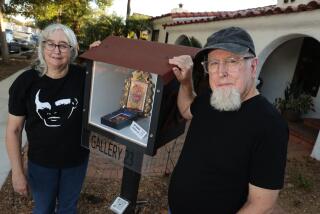Museum of Contemporary Art might try to run Los Angeles Municipal Art Gallery
- Share via
L.A.’s Museum of Contemporary Art is interested in running the city-owned Los Angeles Municipal Art Gallery in Hollywood’s Barnsdall Park, as the cash-starved city government tries to outsource eight arts facilities in hopes of saving about $1.3 million a year.
FOR THE RECORD:
Municipal Art Gallery: An article in the Sept. 4 Calendar about L.A.’s Museum of Contemporary Art being interested in running the city-owned Los Angeles Municipal Art Gallery in Barnsdall Park quoted Olga Garay, executive director of the city’s Department of Cultural Affairs, as saying such a move would save the city between $400,000 and $500,000, including 3 1/2 fulltime positions that would be eliminated if MOCA took over the gallery. It is not known whether city employees at the gallery would lose their jobs if MOCA or another private nonprofit operator took over, as they might be reassigned elsewhere. —
MOCA director Jeffrey Deitch has toured the 10,000-square-foot gallery with curators on his staff, said Olga Garay, executive director of the city’s Department of Cultural Affairs. She expects MOCA to submit a proposal to run the venerable gallery, which was established in 1951 and has occupied its current hilltop building near Frank Lloyd Wright’s Hollyhock House since the early 1970s. It would give the museum a geographical steppingstone between its two downtown facilities and its Westside outpost at the Pacific Design Center. MOCA officials did not respond to a request for comment.
Garay said the city would save between $400,000 and $500,000, including 31/2 fulltime positions that would be eliminated if MOCA takes over the gallery. The prospect of a large museum with a global outlook and reputation taking over does not sit well with Municipal Art Gallery supporters. They cherish its tradition of including Southern California artists who haven’t gotten the broader art-world acclaim, which is typically a requisite for earning attention and exhibition space from high-flying institutions such as MOCA and the Los Angeles County Museum of Art. The gallery’s private, nonprofit support group, Los Angeles Municipal Art Gallery Associates, this week issued a “Dear arts community” letter urging people to write to the mayor and City Council “expressing your concern for the future of the gallery.”
The support group wants the City Council, which will have final say, to require MOCA or any other new operator to substantially continue the gallery’s current mission, including an emphasis on Los Angeles artists and an agenda that won’t sacrifice “populist artistic genres” to approaches that are “new school” or “high art.”
“We don’t want to be viewed as obstructionists. We are very aware of the city’s dire situation,” said Maria Luisa de Herrera, the gallery group’s board president. But with rumors circulating in art circles about MOCA’s interest in the gallery, she said the board decided to take its concerns public even before the city had issued a formal “request for proposals” from all nonprofit groups interested in operating the gallery and the seven other cultural facilities that L.A. hopes to outsource by year’s end. After that, government funding to operate them will run out, barring fresh appropriations from the City Council.
“The idea is just to inform the council that the gallery has a constituency, and it is a very broad and passionate and voting constituency,” De Herrera said.
“It’s a very democratic space. It’s open to just about anybody. A lot of emerging and mid-career artists would not have the opportunity to exhibit in a space like that, and that would be a major loss,” said Mark Steven Greenfield, who, until he recently took an early retirement that the city offered as a cost-cutting measure, had been director of the Municipal Art Gallery.
Turning it into a satellite of a museum with much bigger fish to fry, he said, could “go a long way toward greater stratification of the arts in Los Angeles. Eli Broad and his buddies are already carving up the city culturally the way they want to see it, and a lot of people are going to be left out of the mix.”
Greenfield, 59 and himself an artist, said that the only likely positive from MOCA’s involvement would be that the museum, which has a budget of about $18 million a year, “would probably throw considerable weight behind marketing whatever happened there.”
Greenfield said that in the two years since a $7 admission charge was dropped, annual attendance at the gallery grew from about 4,000 to 25,000 to 30,000. Greenfield and De Herrera said the gallery typically enlists curators from other area museums as jurors who review submissions from artists who want to be included in exhibitions. A flagship event is the annual C.O.L.A. (City of Los Angeles) Exhibition, featuring mid-career artists who win city-paid fellowships that are essentially commissions to create a work for the show. Every other year, the gallery goes ultra-populist with the All-City Open Show, in which anyone willing to pay a modest entry fee can exhibit a work of art. Currently showing is the biennial Los Angeles Juried Exhibition, with entrants picked by curators Franklin Sirmans of LACMA and Ali Subotnick of the Hammer Museum.
When the City Council reviewed the cultural affairs department’s budget in the spring, it ordered the privatization of seven facilities, but not the Municipal Art Gallery. But the City Council subsequently asked to seek a private operator for the municipal gallery as well, because, Garay said, “we might be able to get an organization that could bring resources to the table beyond what the city could devote.” There are potential suitors besides MOCA, she said.
More to Read
The biggest entertainment stories
Get our big stories about Hollywood, film, television, music, arts, culture and more right in your inbox as soon as they publish.
You may occasionally receive promotional content from the Los Angeles Times.











